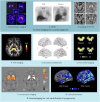Neuroimaging and fluid biomarkers in Parkinson's disease in an era of targeted interventions
- PMID: 38969680
- PMCID: PMC11226684
- DOI: 10.1038/s41467-024-49949-9
Neuroimaging and fluid biomarkers in Parkinson's disease in an era of targeted interventions
Abstract
A major challenge in Parkinson's disease is the variability in symptoms and rates of progression, underpinned by heterogeneity of pathological processes. Biomarkers are urgently needed for accurate diagnosis, patient stratification, monitoring disease progression and precise treatment. These were previously lacking, but recently, novel imaging and fluid biomarkers have been developed. Here, we consider new imaging approaches showing sensitivity to brain tissue composition, and examine novel fluid biomarkers showing specificity for pathological processes, including seed amplification assays and extracellular vesicles. We reflect on these biomarkers in the context of new biological staging systems, and on emerging techniques currently in development.
© 2024. The Author(s).
Conflict of interest statement
R.W. has received speaking and writing honoraria respectively from GE Healthcare and Britannia, and consultancy fees from Therakind, and is local PI for an EIP neflamapimod trial. H.Z. has served at scientific advisory boards and/or as a consultant for Abbvie, Acumen, Alector, Alzinova, ALZPath, Annexon, Apellis, Artery Therapeutics, AZTherapies, Cognito Therapeutics, CogRx, Denali, Eisai, Merry Life, Nervgen, Novo Nordisk, Optoceutics, Passage Bio, Pinteon Therapeutics, Prothena, Red Abbey Labs, reMYND, Roche, Samumed, Siemens Healthineers, Triplet Therapeutics, and Wave, has given lectures in symposia sponsored by Alzecure, Biogen, Cellectricon, Fujirebio, Lilly, and Roche, and is a co-founder of Brain Biomarker Solutions in Gothenburg AB (BBS), which is a part of the GU Ventures Incubator Program (outside submitted work). The remaining authors report no competing interests.
Figures


References
-
- Simuni, T. et al. Biological Definition of Neuronal alpha-Synuclein Disease: Towards an Integrated Staging System for Research 10.1016/S1474-4422(23)00405-2 (2024). - PubMed
Publication types
MeSH terms
Substances
Grants and funding
LinkOut - more resources
Full Text Sources
Medical

